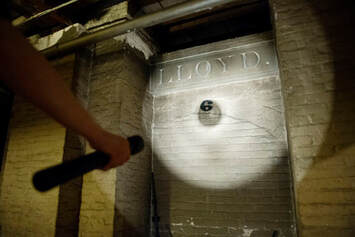KING'S CHAPEL
Remaining Memorials
|
Almost every inch of King’s Chapel’s sanctuary walls are adorned with monuments to former congregants. However, the historic burial space below has just two remaining memorials located above their tomb entrances. This can seem jarring to first-time visitors, especially considering more recent American practices of burial and memorialization. Since the mid-19th century, the dominant form of burial in the United States has been landscaped cemeteries, green spaces with intricate headstones marking the spot of burial. Cemeteries are meant to memorialize the dead and are meant to be visited and explored. When the crypt was active, the dark, pungent space would not have been pleasant to visit. Congregants with family and friends interred below could attend service on Sunday and take comfort in knowing their loved ones lay below, without having to brave the crypt itself. As a result it was not a space for expensive ostentatious memorials. That being said, historically there were memorials in the crypt, both in the form of wood and plaster above the tombs and names either etched in slate or nailed onto the tomb doors. When the city banned the practice of open-air tombs in 1853, the chapel began the process of sealing the tombs and closing the crypt. Around that time all of the doors were removed, and many of the memorials were gradually taken down. What became of them is unknown, but remnants of plaster, wood, and nails can be found on many of the tombs today, indicating where they once were.
Two memorials remain today on tombs six and fifteen. Tomb number six belonged to the Lloyd family, and “Lloyd.” is carved on a large piece of slate above the tomb. Though expensive and large, compared to the memorials upstairs it is almost understated, no family crests or Latin phrases, just the name in block letters. Across the room is the other permanent memorial, on tomb number fifteen, belonging to Joseph Barrell. The memorial on this tomb features not just the name of the owner, but also the year it was likely purchased (1785) and a short group of quotations that read: “‘DEATH is the good man’s FRIEND; and the day of his death is better than the day of his birth. Was DEATH deny’d, e’en FOOLS would wish to die.’ The hope of future life, softens our cares, and heightens every bliss: then rest in peace for we shall live again.” Though wordier than the Lloyd memorial, the Barrell memorial is actually a bit smaller, and the two contrast well offering a pretty clear look into the taste and, in the case of the Barrell tomb, the personality of the owners. |
www.kings-chapel.org | 58 Tremont St. Boston, MA 02108 | 617-227-2155


